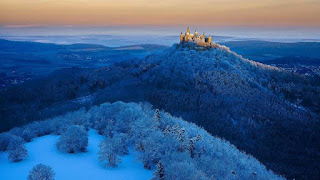"The greatest and noblest pleasure that men can have in this world is to discover new truths; and the next is to shake off old prejudices." ― Frederick II, also known as Frederick the Great (the King of Prussia who belonged to the Hohenzollern dynasty and went on to become the longest ruling monarch from his dynasty)
===================================================================(on the edge of the Swabian Jura of central Baden-Württemberg, in Germany) Baden-Württemberg (commonly shortened to BW or BaWü) is a federal state (Bundesland) in southwest Germany, east of the Rhine River, which forms the southern part of Germany's western border with France. (What is now Baden-Württemberg was formerly the historical territories of Baden, Prussian Hohenzollern, and Württemberg.)
+ Mount Hohenzollern, in BaWü, is topped with the famous Hohenzollern Castle. In nearby Ulm, the swift-flowing blue Danube forms the boundary in the south, while the Neckar runs past half-timbered towns, limestone crags, beech woods, juniper-cloaked heaths, hilltop ducal castles and robber-knight ruins further north. The region is considered a geologist’s dream -- 200 million years ago it had more volcanoes than almost anywhere else on earth. The karst landscape is riddled with caves, where rare fossils and ice age art (including the 30,000-year-old Löwenmensch, on display in Museum Ulm) have been discovered. In 2017, the Swabian Jura Caves and ice age art received UNESCO World Heritage status for having some of the world's oldest figurative art, dating from 43,000 to 33,000 years ago. (This is where the castle's residents hid when enemies were at the gate.) On these stones the Hohenzollern dynasty was built. Here, at the base of the castle, the first stone was laid some 1,000 years ago. Four floors higher, one can see what they made of it. The hall depicting the family tree of one of Europe's most powerful ruling families, includes the names of monarchs and the nobility, stretching from floor to ceiling -- highlighting names like Frederick the Great, the soldier king Frederick William I, and Kaiser Wilhelm II. (indeed, the castle primarily serves as a monument to this prestigious dynasty.
+ By the time the House of Hohenzollern had been named the rulers of the German Empire, the family had an opulent royal seat worthy of a kaiser. The third version of the castle, which stands today, was constructed for King Frederick William IV of Prussia between 1846 and 1867. The castle was built under the direction of architect Friedrich August Stüler, who based his design on English Gothic Revival architecture and the Châteaux of the Loire Valley. The castle was built as a family memorial, thus, no member of the Hohenzollern family was in permanent or regular residence when it was completed. (The winters in these parts were long and severe, meaning the owners limited their presence here to short, official visits.) In 1945 it became home to the last German/Prussian Crown Prince -- Wilhelm - who is buried here with his wife, Crown Princess Cecilie.





No comments:
Post a Comment